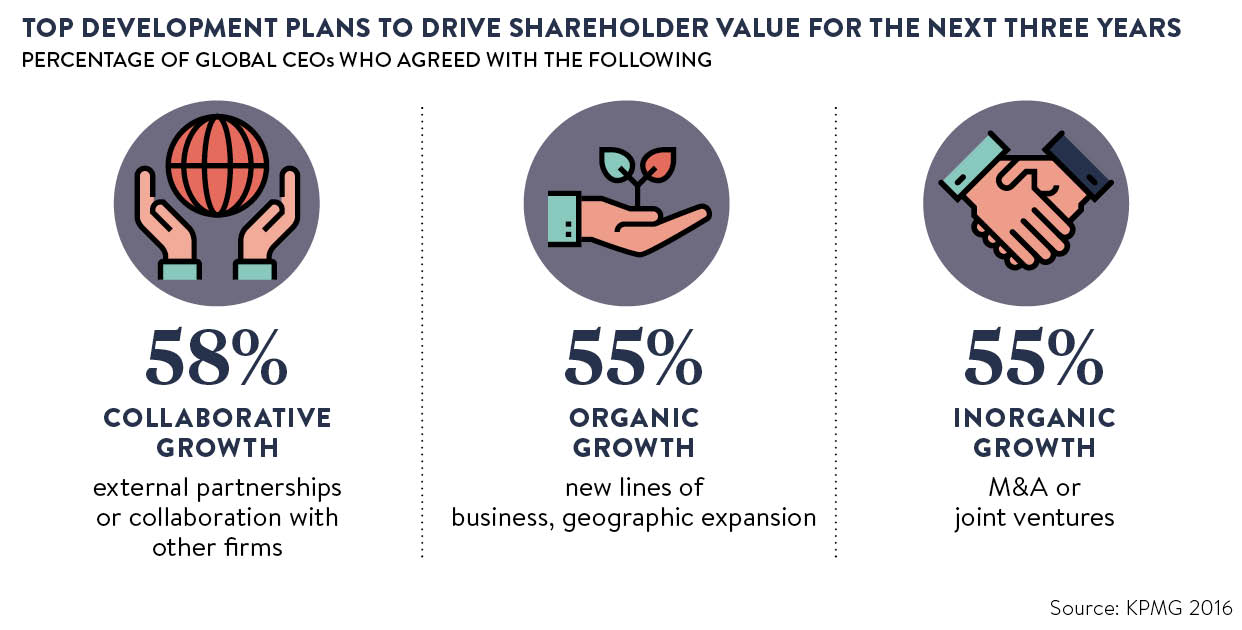At a time when many politicians and their backers seem to encourage a less open outlook and more focus on what happens within a nation’s borders than without, companies are doing the exact opposite. They are looking to collaborate with a wider range of partners than ever and don’t mind where these firms hail from as long as they provide the right service.
“The reality is that more and more people have decided they don’t want to own everything themselves,” says Shamus Rae, partner and head of innovation and investments at KPMG, a big-four professional services firm.
“It started 15 or 20 years ago,” he says, “when companies started outsourcing and has continued since then. It was a case of asking – then and now – ‘Are other organisations more capable of providing services at the right quality than we are?’”
But not only do far more specialist suppliers now use technology to do something better than any conventional corporate behemoth could, it’s also “about talent and where talent wants to go”, says Mr Rae.
“So ten years ago, talent would go into investment banking, into the professions and so on, and that still does go on but, actually after 2008, investment banking talent especially has been going elsewhere and going into startups,” he says.
“The quality of the people in small organisations has gone up dramatically because the new generation don’t feel they have to have a job for life; they want to go do something more interesting, more entrepreneurial. So, to access that talent, and because companies are now more used to dealing with third parties in crucial parts of their business, they are now very comfortable working with other organisations.”
Enterprise agility
In a global KPMG survey of almost 1,300 chief executives, the most common response they gave when asked how they plan to drive shareholder value for the next three years, was that they would pursue collaborative growth – external partnerships or collaboration with other firms.
The reasons for pursuing these kinds of partnerships go deeper than a need to come up with new ideas, however. Analysis from McKinsey, a consultancy, concludes that, compared to the Industrial Revolution, “change is happening ten times faster and at 300 times the scale or roughly 3,000 times the impact”.
So management teams need a way to respond to that change quickly, to test new ideas, fail cheaply and quickly back the most promising. They also need to be able to do this without alienating or confusing employees by giving them a seemingly well-defined job role only to rewrite it six months later.
As Michael Beygelman, co-founder and chief executive of Joberate, that provides data on job-seeking activity, says: “Having previously been the global RPO [recruitment process outsourcing] president at the Adecco Group, I learnt that most large corporations don’t have the infrastructure for agile innovation.”
You can use partnerships to take advantage of fast-moving opportunities
He says they struggle with “unknown and unquantified risk, longer development cycles, no desire to pay for R&D out of operating profits and a lack of talent that has the necessary entrepreneurial skills”.
And those that use partnerships are certainly seeing the benefits. Kanya King, chief executive of the MOBO (music of black origin) Organisation that runs the MOBO Awards, says: “People constantly express surprise at how small the core team at MOBO actually is. We would be hard pressed to achieve what we do with the MOBO Awards and our other ventures without reciprocal partnerships.”
Similarly, chief executive and founder of property website Zoopla, Alex Chesterman, says: “There is so much we want to do and we simply cannot do it all ourselves.” Partnerships with firms such as Trussle and Landbay help Zoopla “differentiate our proposition and stay ahead of our competition”, he says.

Considerations
This is all good news, but management teams must have a clear strategy first. Peter Cheese, chief executive of the CIPD, the UK body for human resources professionals, advises businesses to understand what are the “distinctive capabilities or competencies that you need really to try and build within your own workforce”.
Once you know that you can concentrate on hiring and retaining people with the skills to keep a business excelling at these core activities. Then you can use partnerships to take advantage of fast-moving opportunities. A good partnership will also benefit the often smaller niche suppliers as well. They get a predictable revenue stream, and a way to test and learn with constant feedback from a customer.
KPMG’s Mr Rae cautions that companies should also understand what their partner’s longer-term plans are. Will there be some point in the future when that partner could turn into a competitor or are they already? If so, it’s important for managers to understand what intellectual property and other information they want to share, and what they want to keep confidential.
Mr Rae cites an example of this “co-opetition” as KPMG’s partnership with IBM’s Watson business. IBM recently launched a product to help companies check whether they are complying with certain regulation and that competes directly with some of KPMG’s services. The trick is to be candid about that clash and then work round it. “We absolutely had that conversation,” he says.
All in all, partnerships provide a great way to keep up in a world that’s changing fast and provide much benefit to both parties. But, like good international relations, it helps to know what you want from the partnership before you start and set out the terms of engagement early.
Enterprise agility

